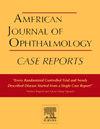Diagnostic interpretation of corneal tomography using a multimodal large language model (ChatGPT)
Q3 Medicine
引用次数: 0
Abstract
Purpose
To describe the use of a commercially available general large language model (LLM) in extracting and interpreting several key metrics from entire raw corneal tomography (Pentacam) reports for the diagnosis of corneal disorders.
Observation
Anonymized corneal tomography biometry reports of 50 eyes of 50 patients with healthy corneas (n = 28), keratoconus (n = 20) and post-surgical ectasia (n = 2) were analyzed by a multimodal general LLM. System prompts were used to extract flat and steep keratometry values (K1 and K2, respectively), astigmatism, pachymetry values and provide an overall diagnosis. Accuracy of data extraction was 100 % across all metrics and the model provided a diagnosis in agreement with the two observers in all eyes. Pachymetry and maximum keratometry values were the most common metric used to formulate the diagnosis and was cited in all eyes. This was followed by specifically citing the highest elevation map values (88 %) and degree of astigmatism (74 %).
Conclusion and importance
In this proof-of-concept study, a commercially available multimodal LLM was able to extract data from raw corneal tomography reports with high accuracy and with retention of spatial context, and formulated correct diagnoses with excellent proficiency. This study demonstrates the use of emerging LLMs as diagnostic adjuncts through the synthesis of multimodal data.
使用多模态大语言模型(ChatGPT)的角膜断层扫描诊断解释
目的描述商用通用大语言模型(LLM)在提取和解释从整个原始角膜断层扫描(Pentacam)报告中诊断角膜疾病的几个关键指标方面的使用。对50例健康角膜(n = 28)、圆锥角膜(n = 20)和术后扩张(n = 2)患者50只眼的匿名角膜断层生物测量报告进行多模态一般LLM分析。系统提示用于提取平角和陡角测量值(分别为K1和K2)、散光、视厚测量值,并提供总体诊断。在所有指标中,数据提取的准确性为100%,该模型提供了与所有观察者一致的诊断。厚视仪和最大角膜测量值是制定诊断的最常用指标,并在所有眼睛中被引用。其次是特别引用最高高程图值(88%)和散光程度(74%)。结论和重要性:在这项概念验证研究中,商用的多模态LLM能够高精度地从原始角膜断层扫描报告中提取数据,并保留空间背景,并非常熟练地制定正确的诊断。本研究通过综合多模态数据证明了新兴llm作为诊断辅助工具的使用。
本文章由计算机程序翻译,如有差异,请以英文原文为准。
求助全文
约1分钟内获得全文
求助全文
来源期刊

American Journal of Ophthalmology Case Reports
Medicine-Ophthalmology
CiteScore
2.40
自引率
0.00%
发文量
513
审稿时长
16 weeks
期刊介绍:
The American Journal of Ophthalmology Case Reports is a peer-reviewed, scientific publication that welcomes the submission of original, previously unpublished case report manuscripts directed to ophthalmologists and visual science specialists. The cases shall be challenging and stimulating but shall also be presented in an educational format to engage the readers as if they are working alongside with the caring clinician scientists to manage the patients. Submissions shall be clear, concise, and well-documented reports. Brief reports and case series submissions on specific themes are also very welcome.
 求助内容:
求助内容: 应助结果提醒方式:
应助结果提醒方式:


